The OnePlus 6 Review: Among The Best Of 2018
by Andrei Frumusanu on July 27, 2018 8:30 AM EST- Posted in
- Mobile
- Smartphones
- OnePlus
- OnePlus 6
Display Measurement & Power
The OnePlus 6 comes with a 6.22” diagonal 19:9 Samsung AMOLED screen sporting a 2280 x 1080 resolution. The first impressions of the screen are generally excellent, be it that the resolution is quite stretched at this large size.
There’s no Android 8.1 colour management available for the screen, while it does support simple HDR content. OnePlus instead relies of various pre-defined colour profiles which can be found in the display settings:
The default mode is a very saturated wide gamut mode not particularly targeting any specific colour space. The firmware provides two accurate modes options representing the sRGB and DCI-P3 colour spaces. The Adaptive mode is also very much a viable alternative that again isn’t accurate to any standard, but comes with good compromises between higher colour saturation and more accurate skin tones.
As always, we thank X-Rite and SpecraCal, as measurements are performed with an X-Rite i1Pro 2 spectrophotometer, with the exception of black levels which are measured with an i1Display Pro colorimeter. Data is collected and examined using SpectraCal's CalMAN software.

Standard (sRGB)
DCI-P3 Adaptive
Starting off with the greyscale measurements we see that the screen fares quite well in terms of accuracy, albeit the colour temperature both in the sRGB and DCI-P3 modes are slightly too warm coming in at 6350K; the Adaptive mode is the only one which comes in at perfect whites of 6586K resulting in one of the bets greyscale dE2000 scores at 1.15.
 SpectraCal CalMAN
SpectraCal CalMAN
sRGB Greyscale Comparison
 SpectraCal CalMAN
SpectraCal CalMAN
Adaptive Greyscale Comparison
In terms of brightness, the screen goes up to a maximum of 420cd/m² in manual mode which is essentially standard for what we’ve seen over the years in terms of AMOLED screens. The more disappointing discovery here is that there’s no high brightness mode under default conditions and it can only be enabled at low-level driver interfaces. In effect this puts the OnePlus 6 at a visible brightness disadvantage in bright conditions, not least because of the lack of raw brightness, but also because it’s not adapting to the artificial low gamma and high saturation colour profiles that that vastly improves sunlight legibility usually found in other AMOLED devices.
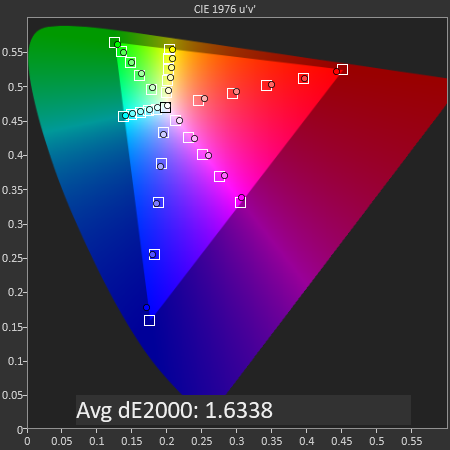
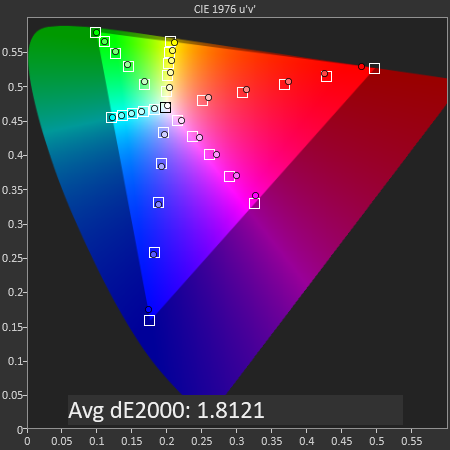 SpectraCal CalMAN
SpectraCal CalMAN
sRGB Mode / DCI-P3 Mode
The gamut and saturations accuracies for the sRGB and DCI-P3 modes are excellent, with only very slight deviations most prominent in magenta colours. In the DCI-P3 mode it also looks like OnePlus undershot the maximum chromacity for reds as it doesn’t quite reach the full gamut of the colour space – there’s also slight oversaturations in both profiles at the lower red levels meaning the colour compression on that channel is perfectly linearly configured.
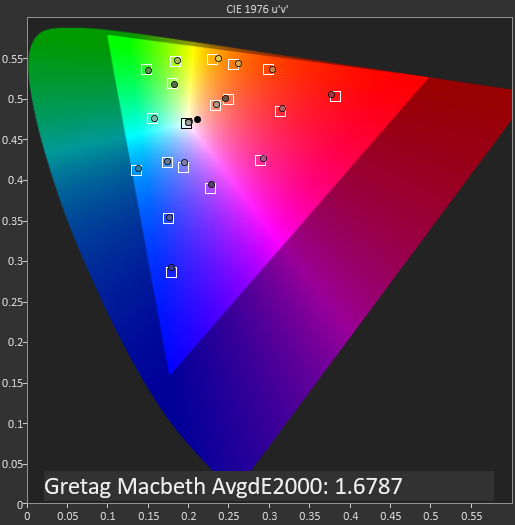
 SpectraCal CalMAN
SpectraCal CalMAN
sRGB Mode / DCI-P3 Mode
In the Gretag Macbeth charts which showcase common colour tones, both sRGB and DCI-P3 profiles perform very well with dE2000 of 1.67 and 1.87, while not perfect, it will be mostly unperceivable to most users in daily usage.
 SpectraCal CalMAN
SpectraCal CalMAN
sRGB GMB Comparison
 SpectraCal CalMAN
SpectraCal CalMAN
DCI-P3 GMB Comparison
The Adaptive mode is again extremely interesting as it doesn’t really adhere to any one colour space, and it’s something we most recently saw implemented in the MIX 2S; it’s a wide gamut colour space (DCI-P3), however skin tones are mapped to the sRGB space. This gives best compromise of bringing vivid colours to objects while attempting to display accurate skin tones. Given that this mode also has the single best pre-defined white-point, I think it’s generally the best alternative for most users.

SpectraCal CalMAN
Adaptive GMB Comparison
Overall the OnePlus 6 is an excellent screen with only two weaknesses; one of not having a high brightness mode at disposal to the user even though the hardware is capable of it, and the second point being that the resolution of the screen being rather stretched out for its form-factor.
In past OnePlus as well as most recent devices reviews we’ve brought up the point of resolution several times; as we’ll see in the battery life section there is effectively no disadvantage to 1440p AMOLED screens in terms of power as their emissive nature isn’t really affected by luminosity power efficiency deficiencies at higher resolutions the same way LCDs are, and the computational overhead of the higher resolution seems to be minimal.
What a 1440p screen would greatly differ in though is pricing, and here maybe OnePlus just isn’t ready to justify the increased component cost for devices that aim to be the best possible value.



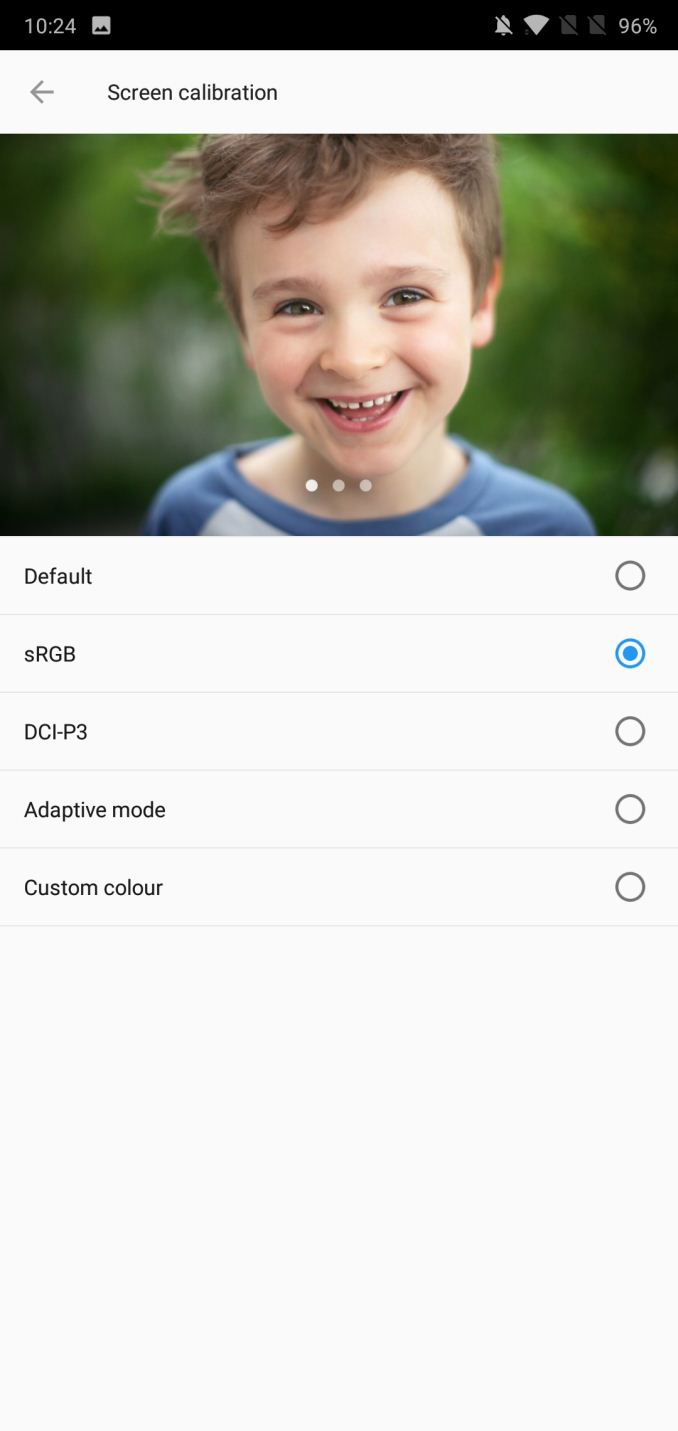
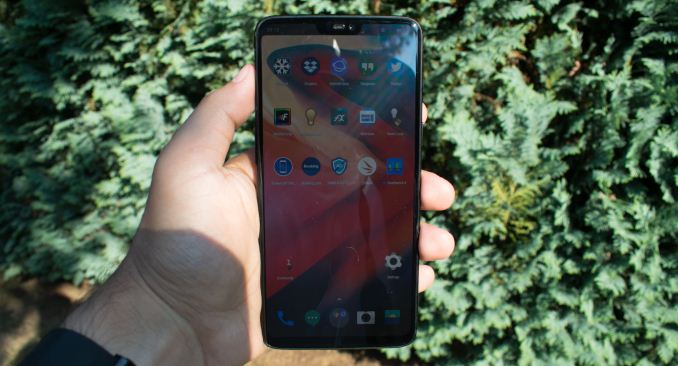
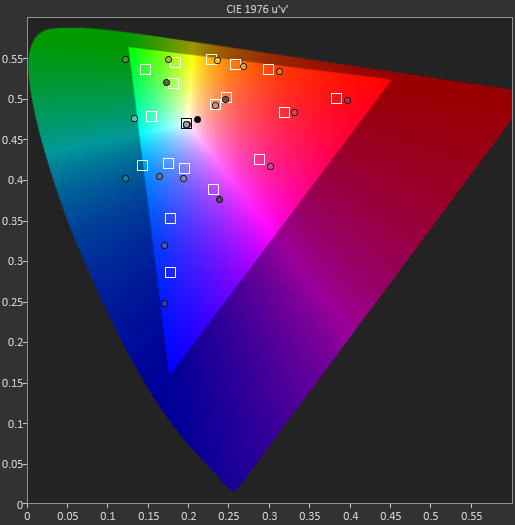








90 Comments
View All Comments
Total Meltdowner - Friday, July 27, 2018 - link
Art Photography? I'm not an unemployed liberal. I like phones to snap photos of family and friends doing things worth remembering.Cooe - Saturday, July 28, 2018 - link
Jesus Christ...Quantumz0d - Friday, July 27, 2018 - link
Starting with the wireless charging changing ergonomics and thickness, I refute. Look up at LG V30 - 7.3mm zero bump no notch. Has Qnovo on top of it, looks better made better with MIL spec. IP68 certified as well. OnePlus failed at Metal design with signal flaw with OP3/T and they cheaped out with glass just for marketing this time. About time when they ditch the jack. OPPO started that with their feeble built Find X.Too soft on Oneplus and other companies notch "there's really nothing controversial" its downright copied from Apple except that keeping the bottom bezel for no reason except to make it a marketing trash. Blacking it out for what ? Breaking the Android apps, but like all mainstream brainwashers Google also decided to add it with utter shameless act. Seems like even at AT no one cares about originality or engineering anymore. Shame
No mention of absence of Video out, Netflix certification. Same battery capacity since OP3T. And Axon 7 from 2016 is able to sell a 1440P AMOLED panel at same/less cost with more features like Stereo front facing. AKM DAC wgich works with Lineage. While OP cuts corners at all specs just increase the RAM and Memory that's it. Pixel 2XL shreds OP in speed with low RAM, not against it but this phone is hot garbage.
Oh this phone doesn't have USB3.0 either. CEO says no one uses when we have LTE pure BS. Why are they incl the high capacity UFS then ? Rubbish selfless corp. After being burned at the Op3 promised blobs and the worst part of this phone not mentioned, the T variant. Which makes the Op6 users look like fools, why don't this get mentioned anywhere ? Is OP paying that hefty ? Guess so since they skimp so much and price increase..its a disgrace.
Sultanxda left OP because they never bother to fix the camera or treat it as some high profile golden IP, or the 821 3T high clock crash. Dash charging, another proprietary technology, no way you can find replacement parts for this phone because 5-6Month EOL is extreme ripping.
dshess - Friday, July 27, 2018 - link
I wish one of the second-tier vendors would commit to long-term hardware support. At $600 (or $800), the story is when they manage to make a phone that sucks - but making an excellent phone for $250 is a great story, especially if you can still purchase the same device a few years later. It's like nobody is even trying to take on the iPhone.icalic - Friday, July 27, 2018 - link
Hi @Andrei Frumusanu,why no more gfxbench manhattan es 3.1 / metal test for battery life and final frame rate @ 200 nits?
i think that test is good for us to look GPU efficiency on every device.
for oneplus 6, i suspect high sustained gfxbench followed by higher power consumption than other snapdragon 845 devices.
Andrei Frumusanu - Friday, July 27, 2018 - link
Power consumption between devices doesn't really change. In this regard I'm keeping the power measurements to the initial SoC reviews of the first devices. The power I measured on the OP6 was not much different than on the S9+ which is covered here: https://www.anandtech.com/show/12520/the-galaxy-s9...The final frame rate benchmark has been superseded by the sustained performance measurements across all 3D workloads, so there's no need for a separate metric.
As for battery measurement in 3D workloads, I think the GFXBench test as an actual *battery* test didn't really convey a lot other than a maximum rundown test. I think having a phone loop in an actual commonly released game would be better representative. As a reminder, the SoC's power consumption will differ greatly at different frequencies and real games will be Vsync capped at 60fps, so in actual use-cases the MH3.1 battery test didn't really show a representation of such use-cases. Currently I'm still thinking about a way to do this better and hopefully the methodology will evolve, but for now it's as it is due to practical reasons.
arvindgr - Friday, July 27, 2018 - link
In OnePlus 3 review, AT included note on USB, that they're still using USBv2! But 4 generations later OP6 still packs that same USBv2 tech. Also with Oppo proprietary charging tech, they are least bothered about USB-PD standards which its SoC supports via QCv4. Why such tech implementations weren't discussed at all..?Andrei Frumusanu - Friday, July 27, 2018 - link
USB 3.0 has issue with creating radio frequency interference in the 2.4GHz band which requires vendors to do a lot more engineering in terms of shielding, that's why a *lot* of phones don't support it.In regards to fast charging techniques - first of all ever since I came back to AT I haven't had the opportunity to re-test all the devices over the last year that we were missing data on. Secondly I didn't prioritise this as much because I feel after 5V/2A/10W which essentially every device nowadays supports, faster charging rates become diminishingly relevant.
Batteries are supposed to be charged at a maximum of 1C, for the OP6 that's for example 3.3A since the capacity is 3.3Ah. A 10W charger is already 2.38A, going to 15W is getting near the limit. Devices nowadays also have like 10 different charging profiles depending on what power supply you connect to it, so while true we can resume testing the stock charger, but again in reality how representative is that really for most people, especially among AT readers?
Quantumz0d - Friday, July 27, 2018 - link
Appreciate the response for this. I always wonder what's the reason behind cutting costs for USB spec. And about the Dash charge, it's proprietary you are stuck with using the accessories from OP site only and usable with their HW only. Its not about speed its about adopting standards like USB PD or QC.Andrei Frumusanu - Friday, July 27, 2018 - link
> Its not about speed its about adopting standards like USB PD or QC.I think that's a weird attitude to take. QC or PD are just ways to achieve speed. A 10W 2A non-standard charger will charge the same as a 10W QC, PD, Dash or whatever charger. Electrons don't care about the standard.